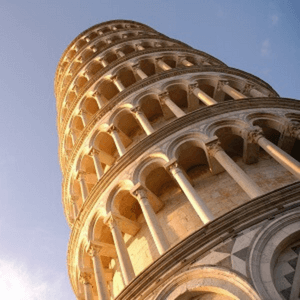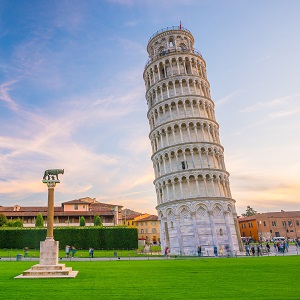Why was it built? Why does it tilt? These are just some of the question we’ll be answering in this quick history of the Leaning Tower of Pisa!
The Leaning Tower of Pisa is undoubtedly the most magnificent Romanesque architecture in Italy. Reckoned as a UNESCO World Heritage Site, this monument is an absolute miracle of medieval engineering. In fact, this gravity-defying freestanding white bell tower with its distinctive tilt has attracted tourists from all around the world! In order to help familiarise yourself with the fascinating history of this iconic structure, we’ve done the groundwork for you on the dramatic evolution of the Leaning Tower of Pisa:
Why was it Built?
The Tower was a part of the grand project to flaunt both the military victories and grandeur of Pisa. Around the year 1000 Pisa was one of the four maritime republics who built fleets of ships both for their own protection and to support extensive trade networks across the Mediterranean, giving them an essential role in the Crusades. With this Pisa’s fame and power gradually grew over the years, as they became involved in various military conflicts and trade agreements. In their notable establishment they sacked many cities and were granted many privileges, such as immunity from taxation. This grew their prestige and their wealth and it was decided that they would demonstrate this by building a grand cathedral complex called the ‘Field of Miracles’. The plan included a cathedral, baptistery, cemetery and a bell tower. Today this complex is known as the Piazza dei Miracoli (the Square of Miracles) and is recognised as one of the finest architectural complexes in the world. The Leaning Tower itself wasn’t intended to be more significant than its neighbouring builds, simply being a characteristic feature of Catholic Churches, but naturally its 4 degree lean made it unique in its grandeur.
The Tale of Construction
While there has been much controversy over the real identity of the architect who constructed the tower, it is Giovanni di Simone whose name is majorly attributed for designing this human marvel! The construction began with full force on 9th August 1173 and continued until 1178. But soon into its construction it was obvious that the building was starting to lean. First noted when three of the tower’s eight stories had been built, Simone attempted to use slightly smaller components on the short side to compensate for the lean, however the weight of the extra floors only cause the edifice to sink further and lean more. It was concluded that the presence of soft alluvial soil on one side of the buildings foundations was causing the tower to lean due to its weak, unstable ground. An element that would have flawed the design from the beginning if it had been known or considered. Without being able to fix the problem or build anymore, the project was discontinued and the construction was subsequently halted for almost a century, as Pisa engaged in battles with Genoa, Lucca and Florence.
History of Stabilisation
Fortunately this gave time for the underlying soil to settle, otherwise the tower would almost have certainly toppled. From December 1233, the tower’s construction continued with efforts to keep building whilst compensating for the tower’s tilt. In 1272, for example, under the architect Di Simone, engineers built upper floors with one side taller than the other, and it is because of this that the tower is curved. Eventually the bell tower was added in 1372, with the largest of the seven bells installed in 1655. The length of the project, caused by a mixture of construction failures, war and differing architects and designers makes the completion of the Leaning Tower even more impressive. Its struggles can be seen in the fact that it still leans, whilst its combination of Gothic and Romanesque style demonstrate its centuries worth of production.
Interestingly despite its unstable structure the tower is still with us today, surviving wars and natural disasters. It’s believed that at least four earthquakes have hit the Pisa region since 1280, but the apparently vulnerable Leaning Tower remained. Engineers have concluded that this is a result of the dynamic soil-structure interaction which enables the Tower to withstand tremors. Through a combination of the buildings height and stiffness and its soft foundations, the Tower does not resonate with earthquake ground motion, making its greatest vulnerability its cause of survival.
It wasn’t until May 2008 however, that it was announced that the tower had stopped moving for the first time in history. This is thanks to the worldwide request put out by the Italian government in 1964, asking for aid in preventing the tower from toppling. In response a multinational task force of architects, mathematicians, and engineers gathered on the Azores islands to come up with different stabilisation methods. Many methods were considered, including the addition of 800 tonnes of lead counterweights to the raised end of the base. During this stabilisation period the tower was closed to the public from 1990 – 2001. The bells were removed from atop to relieve some weight, and sturdy cables were cinched around the tower’s third level and affixed several hundred meters away to provide additional support. The chosen solution aimed to straighten the tower to a safer angle by removing 38 cubic meters of soil from underneath the elevated end, successfully straightening the tower by 45 cm.
With so much hard work and combined efforts gone into saving the Leaning Tower of Pisa it would be rude not to pay it a visit. To find out more, check out some of our Pisa tours below!
Explore Our Pisa Tours
-
Half Day Pisa Tour from Florence
5.5 Hours
€55
See More -
1 Hour Guided Pisa Tour
1 Hour
€15
See More -
Two Hour Pisa Walking Tour
2 Hours
€38
See More -
Pisa & Lucca Day Trip from Florence
9 Hours
€65
See More





